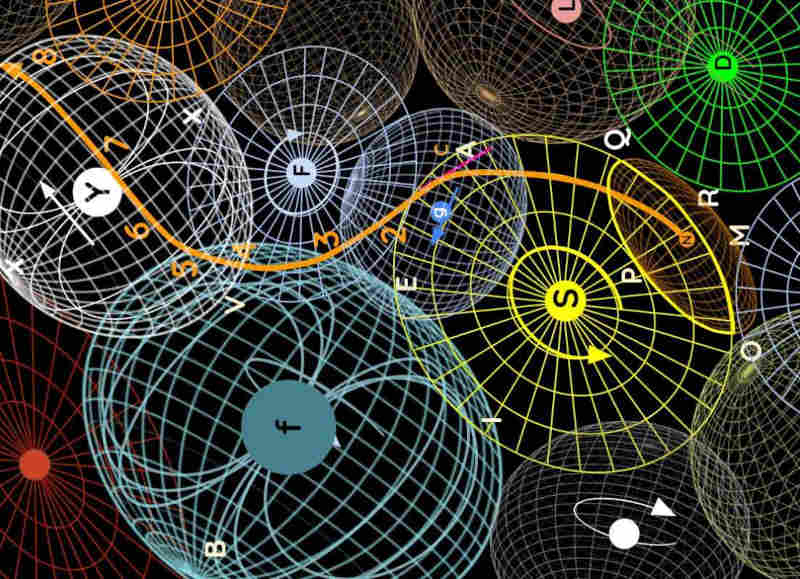Basic Principles of Cartesian Cosmology
Table of Contents
20. The fixed stars are far as possible from Saturn
- We are not yet sure how far the fixed stars are from us.
They are not just beyond Saturn, as everyone commonly admits.
We should be free to estimate them as much farther.
If we wanted to compare their distance with the distances above the Earth that are known to us, the current distance beyond Saturn would seem plausible.
But if we consider the omnipotence of God the Creator, distances can be very vast. And so the distance between stars would can also be much greater than that beyond Saturn.
I will show below that a great space must be placed between the stars and the sphere of Saturn in order to explain the phenomena of the planets and the comets.
21. The Sun is like a flame, consisting of very mobile matter, but it does not migrate from one place to another.
- The Sun is like the fixed stars and is similar to a flame in that it emits light from itself.
It also is:
- like the flame in terms of motion
- like the fixed stars in terms of position
Nothing beyond the Earth is more mobile than flame.
Flame dissolves other bodies that are placed near it and then moves them with it, unless they are very solid and hard.
But the motion of the flame occurs only in its parts. It does not usually migrate as a whole from one place to another unless it is carried by another body to which it adheres.
In this way, we can also think that the Sun consists of very fluid and mobile matter, which drags all the surrounding parts of the heavens with it.
But nonetheless, it imitates the fixed stars in that it does not migrate from one region of the heavens to another.
22. The Sun differs from flame in that it does not need fuel in the same way.
Nor should the comparison of the Sun with flame seem inappropriate, given that we do not see any flame here that does not continuously need fuel, which is not observed for the Sun.
A flame, like any other body, continues to exist unless destroyed by some external cause.
It consists of very fluid and mobile matter. And so it is constantly dissipated here above the Earth by the surrounding matter.
Thus, it needs fuel:
- to preserve what already exists
- so that new matter always takes its place when it is extinguished
However, the air-aether around the Sun does not destroy it in this way. This is why the sun does not need fuel to be repaired.
Yet it will also be shown below that new matter always enters the Sun, and other matter escapes from it.
23. All fixed stars do not revolve in the same sphere. Instead, each one has a vast space around it, free from other fixed stars
The Sun does not differ from the fixed stars in position. They do not all revolve around one sphere, as many suppose. This is because the Sun cannot be on the same circumference of that sphere.
The Sun has a vast space around it which has no fixed stars. Likewise, each fixed star is very distant from all the others, and some much more than others, from us and the Sun.
In the drawing:
Sis the SunFandfare the fixed stars- There are countless other stars above and below and beyond the plane of this drawing, scattered through all dimensions of space

24. Outer Space is Fluid
- The fire-aether of the Sun and fixed stars and the entire heaven [air-aether territory] is fluid or liquid, which all astronomers now generally concede.
They see that the phenomena of the planets can hardly be explained otherwise.
25. The heavens carry along all bodies contained within them
People attribute fluidity to the heavens, yet they imagine it as a completely empty space that:
- does not resist the motions of other bodies
- has no force to carry them along
But no such vacuum exists.
All fluids do not resist the motions of other bodies only when the fluids are themselves are also in motion.
This motion can easily go in all directions. Its force determines it to go in any one direction.
Towards that direction, it necessarily carries along all the other bodies contained within it no matter how solid, stationary, and hard they may be, unless these are held back by any external cause.
26. The Earth rests in its heaven but is nonetheless carried by it
- The Earth is supported by no columns, hung by no ropes.
Imstead, it is surrounded on all sides only by the most fluid outer space.
We should think that it rests and has no inclination to move, since we perceive none.
But we should not think this hinders it from being carried by that heaven and obeying its motions while remaining immobile: just as a ship, driven by no winds or oars, and anchored by no anchors, rests in the middle of the sea, even if perhaps a vast mass of water, descending with a hidden course, carries it along.
27. The same should be thought of all the planets.
The other planets, like the Earth, are opaque and reflect the Sun’s rays.
The planets are also similar to the Earth in the sense that each one rests in the region of outer space which moves it.
All variation in position observed in them arises only because all the matter of the outer space which contains them moves.